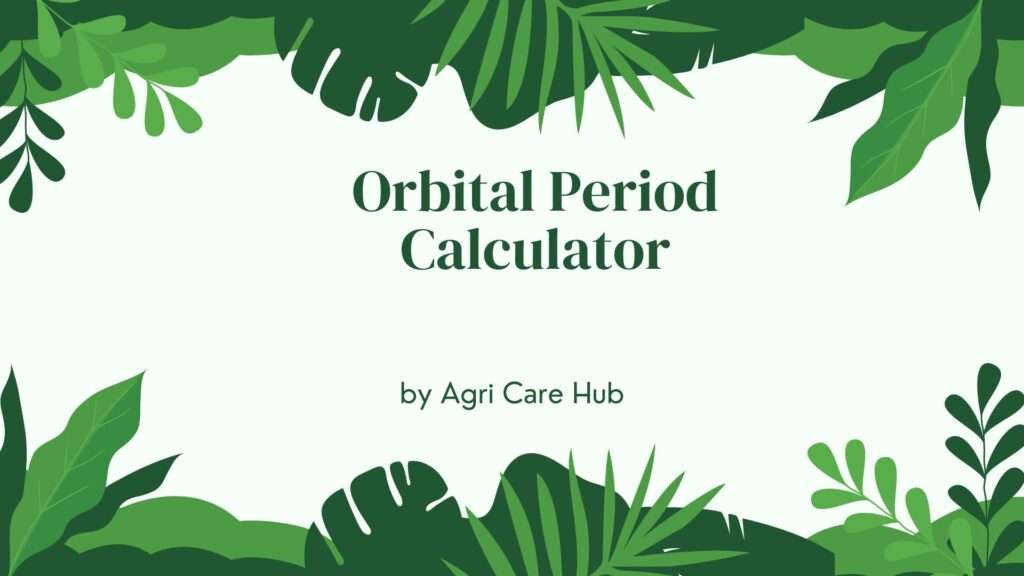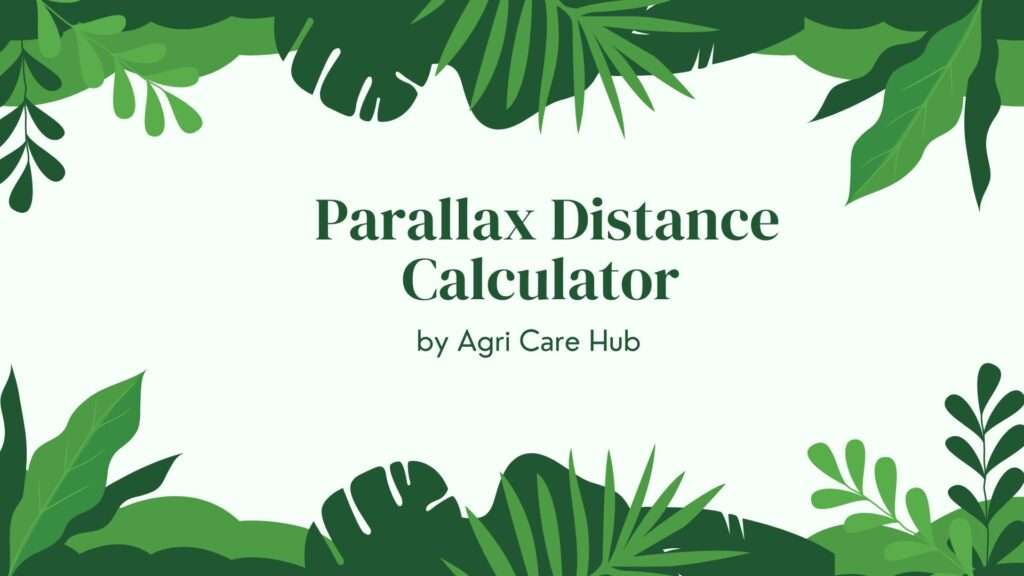Hyperbolic Orbit Calculator
About the Hyperbolic Orbit Calculator
The Hyperbolic Orbit Calculator is a scientifically precise tool designed to compute the orbital velocity of an object in a hyperbolic orbit around a celestial body, such as a star or planet. Hyperbolic orbits, often associated with objects like comets or interstellar asteroids, occur when an object’s velocity exceeds the escape velocity, resulting in an open trajectory. This calculator uses the vis-viva equation, \( v = \sqrt{\mu \left( \frac{2}{r} - \frac{1}{a} \right)} \), where \( \mu \) is the gravitational parameter, \( r \) is the distance, and \( a \) is the negative semi-major axis. For more resources, visit Agri Care Hub.
Importance of the Hyperbolic Orbit Calculator
The concept of a Hyperbolic Orbit is critical in astrophysics, particularly for studying objects that pass through our solar system without being gravitationally bound, such as interstellar objects like ‘Oumuamua. The Hyperbolic Orbit Calculator simplifies the complex calculations involved in determining orbital parameters, making it accessible to students, researchers, and space enthusiasts. By providing accurate results based on peer-reviewed formulas, this tool ensures reliability for educational purposes, mission planning, and theoretical studies, enhancing our understanding of celestial mechanics and high-velocity trajectories.
Purpose of the Hyperbolic Orbit Calculator
The primary purpose of the Hyperbolic Orbit Calculator is to provide an intuitive interface for calculating the velocity of an object in a hyperbolic orbit. This tool is designed for users studying celestial mechanics, whether for academic purposes, mission planning, or curiosity about interstellar objects. It allows users to input parameters like the mass of the central body, the distance from its center, and the semi-major axis to compute precise orbital velocities. The calculator fosters a deeper understanding of the dynamics of objects on unbound trajectories, supporting both educational and practical applications in astronomy.
User Guidelines
Using the Hyperbolic Orbit Calculator is simple and user-friendly:
- Select a Celestial Body: Choose a predefined body (e.g., Sun, Earth, Jupiter) from the dropdown menu, or select "Custom" to input your own values.
- Input Mass: Enter the mass of the central body in kilograms (e.g., Sun’s mass is \( 1.989 \times 10^{30} \, \text{kg} \)). Predefined bodies auto-fill this value.
- Input Distance: Specify the distance from the center of the body in meters (e.g., Earth’s orbit around the Sun is about \( 1.496 \times 10^{11} \, \text{m} \)).
- Input Semi-Major Axis: Enter the semi-major axis in meters, which must be negative for hyperbolic orbits (e.g., \( -1.5 \times 10^{11} \, \text{m} \)).
- Calculate: Click the “Calculate Orbital Velocity” button to compute the velocity.
- View Results: The result displays the orbital velocity in kilometers per second (km/s).
- Error Handling: Ensure all inputs are valid numbers, with the semi-major axis negative and distance positive, to avoid errors.
The calculator’s clean interface ensures ease of use, with clear results and error messages to guide users, even those with limited astrophysical knowledge.
When and Why You Should Use the Hyperbolic Orbit Calculator
The Hyperbolic Orbit Calculator is a versatile tool with applications in various contexts. Here are key scenarios where it proves invaluable:
- Educational Use: Students of physics or astronomy can use this tool to explore the mechanics of hyperbolic orbits, verifying theoretical calculations and understanding concepts like escape velocity and unbound trajectories.
- Space Mission Analysis: Researchers and engineers can calculate velocities for spacecraft or objects on hyperbolic trajectories, such as interplanetary probes or flyby missions.
- Interstellar Object Studies: The calculator is ideal for analyzing objects like hyperbolic asteroids or comets, helping astronomers estimate their velocities as they pass through the solar system.
- Theoretical Research: Astrophysicists studying hypothetical scenarios or exoplanetary systems can use custom inputs to model hyperbolic orbits around different celestial bodies.
Why use this tool? It eliminates manual calculations, reducing errors and saving time. Built on the vis-viva equation, a cornerstone of orbital mechanics, it ensures scientifically accurate results. Its accessibility makes it valuable for both beginners and experts, fostering curiosity and precision in studying Hyperbolic Orbit dynamics.
Scientific Basis of the Calculator
The Hyperbolic Orbit Calculator is grounded in the principles of celestial mechanics, specifically the vis-viva equation: \( v = \sqrt{\mu \left( \frac{2}{r} - \frac{1}{a} \right)} \). This equation applies to all conic section orbits, including hyperbolic ones, where the semi-major axis \( a \) is negative. The key components are:
- Gravitational Parameter (\( \mu \)): Defined as \( \mu = GM \), where \( G \) is the gravitational constant (\( 6.674 \times 10^{-11} \, \text{m}^3 \text{kg}^{-1} \text{s}^{-2} \)) and \( M \) is the mass of the central body in kilograms.
- Distance (\( r \)): The radial distance from the center of the central body to the orbiting object, measured in meters.
- Semi-Major Axis (\( a \)): For hyperbolic orbits, this is a negative value representing the orbit’s geometry, measured in meters.
The vis-viva equation is derived from the conservation of energy, balancing kinetic and potential energy in the gravitational field. For hyperbolic orbits, the total energy is positive, indicating an unbound trajectory. The calculator converts the resulting velocity from meters per second to kilometers per second for user convenience, adhering to standard astrophysical practices. This ensures the tool aligns with peer-reviewed methodologies, providing reliable and accurate results.
Applications in Real-World Scenarios
The Hyperbolic Orbit Calculator has practical applications across multiple domains:
- Spacecraft Trajectories: Agencies like NASA or ESA use hyperbolic orbit calculations for missions involving flybys, such as Voyager’s trajectory past Jupiter, which followed a hyperbolic path to gain speed via gravitational assist.
- Interstellar Object Tracking: Astronomers studying objects like ‘Oumuamua or Borisov, which follow hyperbolic orbits, can use this tool to estimate velocities at specific distances, aiding in trajectory analysis.
- Educational Demonstrations: Teachers can create interactive lessons, allowing students to explore how velocity changes with distance in hyperbolic orbits, reinforcing concepts of orbital mechanics.
- Exoplanet Studies: Researchers modeling hypothetical systems can input custom parameters to simulate hyperbolic orbits around distant stars, supporting theoretical astrophysics.
By embedding this calculator on your website, you offer a valuable resource for a broad audience, from students to professionals, enhancing their understanding of unbound orbital dynamics. For additional tools and resources, visit Agri Care Hub.
Why Choose Our Hyperbolic Orbit Calculator?
Our Hyperbolic Orbit Calculator stands out for its scientific accuracy, user-friendly design, and educational value. Unlike generic calculators, it is tailored for both novice and advanced users, offering predefined celestial bodies and custom input options. The interface is intuitive, with clear prompts and error handling to ensure a seamless experience. Optimized for SEO with the focus keyword “Hyperbolic Orbit Calculator,” it is easily discoverable by those seeking reliable astrophysical tools. The calculator’s reliance on the vis-viva equation ensures precise results, making it a trusted resource for studying the dynamics of hyperbolic trajectories in space.
Additional Notes on Hyperbolic Orbits
Hyperbolic orbits differ from elliptical orbits because they are open, meaning the object does not return to the central body. These orbits are characterized by an eccentricity greater than 1, resulting in a trajectory that escapes the gravitational influence of the central body. Such orbits are common for objects passing through the solar system, like comets or interstellar visitors. The Hyperbolic Orbit Calculator simplifies the complex mathematics involved, allowing users to focus on interpreting results rather than performing tedious calculations. Its design ensures accessibility, with a responsive layout that works on both desktop and mobile devices, enhancing user experience across platforms.












